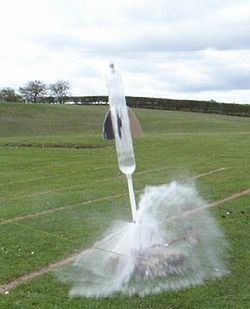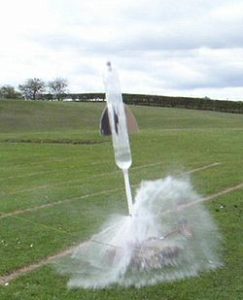“Water Rockets”

Photo from wikipedia: A water rocket launch.
By Scott Hamilton
I was thinking back this week about one of my favorite science clubs in Junior High, and I’m still amazed at how long ago that really occurred. It was the summer of 1985, and our science teacher arranged a summer science rocketry club. We learned how to measure the height and speed of our flights using an average of calculating the height from the gravitational constant, and from using trigonometry to calculate the height based on the angle of ascent. I don’t remember any of the details of my flight, but I do remember wanting to get into the hobby. However, we didn’t have a lot of money and the rocket engines for the Estes model rockets were three dollars apiece; they are now four. That was half my allowance, and I also needed all the extra stuff, like the launchpad, ignitors, and the rockets themselves.
It was then that I discovered water rockets, which were basically a plastic bottle with a rocket nozzle and a release valve. You would use a bicycle pump to pressurize the bottle with a 50 percent mix of water and air. They flew almost as high as the ones with the rocket engines, but they were much less exciting because there was no fire. The thing that brought back this memory was a YouTube video about the world record water rockets. I was amazed when mine made it over the top of the two story house, but let me just say I was nowhere close to a record. I was also wrong about the lack of excitement and danger involved with water rockets.
I learned that there are two organizations around water rocket altitude records and the records are dependent upon the class of water rocket. The simplest to build is the Class A Single Stage rocket, which has a current record of 2,044 feet set on June 14, 2007, by a group called U.S. Water Rockets. Class B water rockets, which are a much more complex two-stage rocket design, currently do not have an official record according to the WRA2.org. There is an unofficial record of 1,060 feet set by Bruce Berggren with his “Millennium” rocket. You can register and be the first team to claim a world record for a two stage rocket, if you can figure out the complex auto-release for the second stage.
Class C rockets are designed for sustained flight duration, and are more about staying in flight the longest, not necessarily about height or even distance. The current record holder is D&P Rockets with the Project 1.5 rocket. Class D rockets are required to be designed using non-reinforced plastic bottles. The pressures you can sustain in a non-reinforced bottle are limited, making this a more difficult record to set. Kevin Colvill with his Valkyrie3 set the record on September 3, 2017, at 417 feet.
The Class E rockets are based on an open design; you can pretty much build anything you want out of non-reinforced bottles. There is currently no official or unofficial record for this class of rocket. There is one final category of water rockets which are designed to run across the ground in dragster fashion. There are two world records currently set with a distance of 364.99 feet in 5.13 seconds, by Hornsby Heights Water Rockets Space Agency.
The first records have been reset because of the new requirement to carry a camera and altimeter to set the record. Before this requirement there were quite a few records that were much higher than those listed as the current world record. One particular unofficial record is recorded on YouTube with a Class B rocket on August 14, 2024, reaching a height of 5,313 feet, just over a mile high. The video was produced by Air Command Rockets, and according to their records, they pressurized the two stage rocket at over 1000 psi, almost ten times the amount of pressure in your standard car tire.
I was surprised to find that there are regulations and complete clubs around water rockets, and many of the records are held by University Rocketry teams. After reading a lot on this topic, it is something I would love to get involved in, but I imagine that once you are at this level, the cost for what should be a relatively free hobby can rapidly exceed the cost of the Estes rocket kits. I hope you enjoyed learning about an interesting new hobby.
Until next week, stay safe and learn something new.
Scott Hamilton is an Expert in Emerging Technologies at ATOS and can be reached with questions and comments via email to shamilton@techshepherd.org or through his website at https://www.techshepherd.org.






